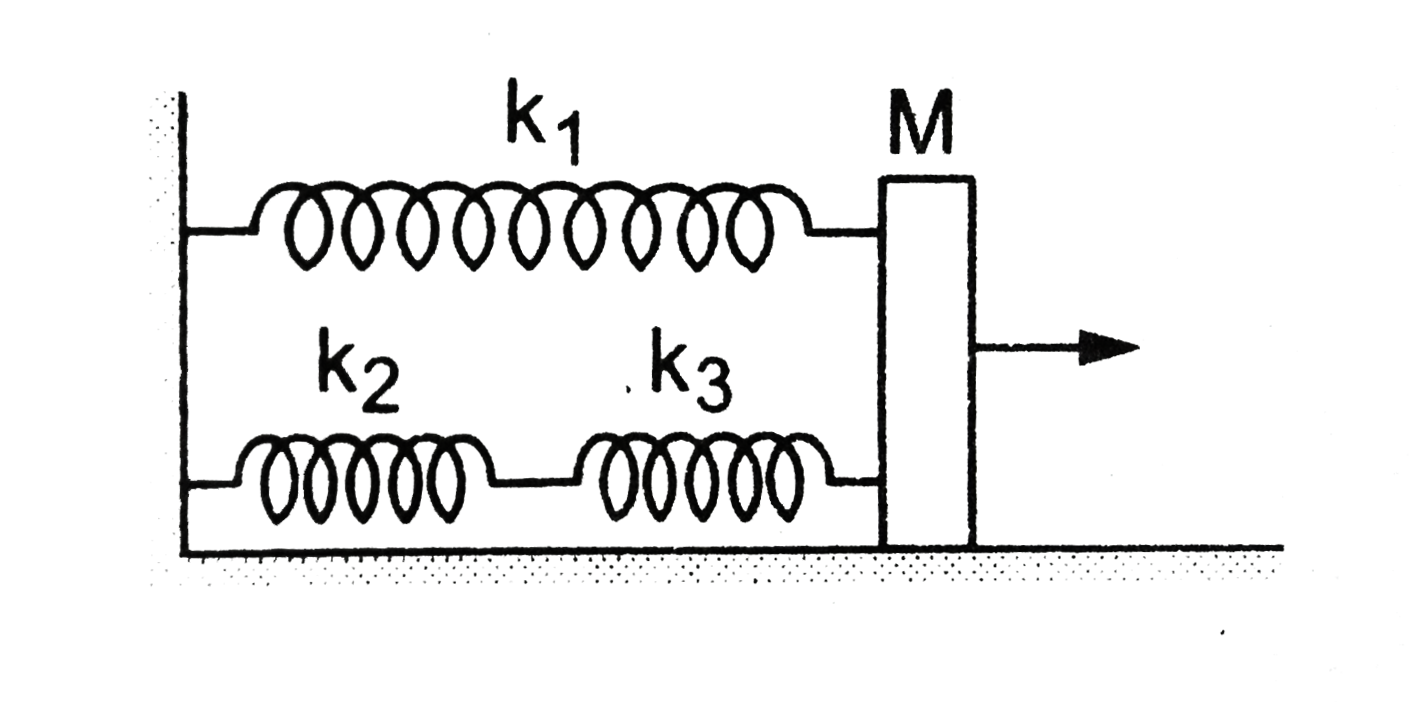Complete Solutions to Exercises of chapter SIMPLE HARMONIC MOTION of Class 11 book with complete answers and questions
| Class 11 | PHYSICS |
| Chapter | SIMPLE HARMONIC MOTION |
| HC VERMA | Exercises |
| Number Of Questions | 58 |
| Academic Year | 2023-24 |
A particle executes simple harmonic motion with an amplitude of 10 cm and time period 6s. Ast t=0 it is at position x=5 cm going towasrds positive x-direction. Write the eqwuation for the displacement x at time t. Find the magnitude of the acceleration of the particle at t=4s.
View SolutionThe position velocity and acceleration of a particle executihg simple harmonic motionn asre found to have magnitudes 2cm, 1ms^-1 and 10ms^-2 at a certain instant. Find the amplitude and the time period of the motion.
View SolutionA particle executes simple harmonic motion with an amplitude of 10 cm. At what distance from the mean position are the kinetic and potential energies equal?
View SolutionThe maximum speed and accelerastion of a pasrticle executing simple harmonic motion are 10 cm s^-1 and 50 cms^-2. Findthe position s of the particle when the speed is 8cms^-1.
View SolutionA particle having mass 10 g oscilltes according to the equatioi `(x=(2.0cm) sin[(100sin^-1)t+pi/6]`. Find a the amplitude the time period and the spring constant b. the position, the velociyt and the acceleration at t=0.
View SolutionThe equation of motion of a particle started at t=0 is given by `x=5sn(20t+pi/3)`, where x is in centimetre and t in second. When does the particle
a. first come rest
b. first have zero acceleration
c. first have maximum speed?
View SolutionConsider a particle moving in simple harmonic motion according to the equation
`x=2.0cos(50pit+tan^-10.75)`
where x is in centimetre and t in second. The motion is started at t=0. a. When does the particle come to rest for the first time? B. When does the acceleration have its maximum magnitude for the first time? c. When does the particle comes to rest for the second time?
View SolutionConsider a simple harmonic motion of time period T. Calculate the time taken for the displacement of change value from half the amplitude to the amplitude.
View SolutionThe pendulum of a clock is replaced by a spring mass system with the spring having spring constant `0.1Nm^-1`. What mass should be attached to the spring?
View SolutionA block suspended from a vertical spring is in equilibrium. Show that the extension of the spring equals the length of an equivalent simple pendulum, i.e., a pendulum having frequency same as that of the block.
View SolutionA block of mass 0.5 kg hanging from a vertical spring executes simple harmonic motion of amplitude 0.1 m and time period 0.314s. Find the maximum fore exerted by the spring on the blockl.
View SolutionA body of mass 2 kg suspended through a vertical spring executes simple harmonic motionof period 4s. If the oscillations are stopped and the body hangs in equillibrium, find the potential energy stored in the spring.
View SolutionA spring stores 5J of energy when stretched by 25 cm. It is kept vertical with the lower end fixed. A block fastened to its end is made to undergo small oscillations. If the block makes 5 oscillations each second what is the mass of the block?
View SolutionA small block of mass m is kept on a bigger block of mass M which is attached to a vertical spring of spring constant k as shown in the figure. The system oscilates verticaly. a.Find the resultant force on the smaller block when it is displaced through a distance x above its equilibrium position. b. find the normal force on the smaller blok at this position. When is this force smallest smaller block at this position. When is this force smallest in magnitude? c. What can be the maximum amplitude with which the two blocks may oscillate together?

View SolutionThe block of mass `m_1` shown in figure is fastened to the spring and the block of mass `m_2` is placed asgainst ilt. A. Find the compression of the spring in the equilibrium position. b.The blocks are pushed a further distance `(2/k)(m_1+m_2)gsintheta` against the spring and released. Find the position where the two blocks separate. c. What is the common speed of blocks at the time of separation?

View SolutionIn figue `k=100Nm^-1 M=1kg and F=10N`. a. Find the compression of the spring in the equilibrium position. b. A sharp blow by some xternal agent imparts a speed of `2ms^-1` to the block towards left. Find the sum of the potential energy of the spring and the kinetic energy of the block at ths instant. c. find the time period of the resulting simple harmonic motion. d. Find the ampitude. e. Write the potential energy of the spring when the block is at the left extreme. f. Write teh potential energy of the spring when teh block is at the right extreme.
The anwer of b, e, and f are different. Explain why this does not violate the principle of conservation of energy.

View SolutionFind the time period of the oscillation of mass m in figure a,b,c what is the equivalent spring constant of the pair oif springs in each case?

View SolutionThe spring shown in figure is unstretched when a man starts pulling on the cord. The mass of the block is `M`. If the man exerts a constant force `F`, find

(a) the amplitude and the time period of the motion of the block,
(b) the energy stored in the spring when the block passes through the equilibrium position and
(c) the kinetic energy of the block at this position.
View SolutionA particle of mass m is asttached to three springs A,B and C of equla force constants k as shown in figure. If the particle is pushed slightly against the spring C and released, find the time period of oscillastion.

View SolutionRepeat the previous exercise if the angle between each pair of springs is `120^@` initially.
View SolutionThe springs shown in the figure are all unstretched in the beginning when a man starts pulling the block. The man exerts a constant force F on the blcok. Find the amplitude and the frequency of the motion of the block.

View SolutionFind the elastic potential energy stored in each spring shown in figure, when the block is in equilibrium. Also find the time period of vertical oscillation of the block.

View SolutionThe string ,the spring and the pulley shown in figure are light. Find the time period of the mass m.

View SolutionSolve the previous problem if the pulley has a moment of inertia I about its axis and the string does not slip over it.
View SolutionConsider the situastion shown in figure. Show that if that blocks are displaced slightly in opposite directions and released, they will execute simple harmonic motion. Calculate the time period.

View SolutionA rectangular plate of sides a and b is suspended fropm a ceilling by two parallel strings of length L each figure. The separation between the strings is d. The plate is displaced slightly in its plane keeping the strings tight. Show that it will execute harmonic motion. Find the time period.

View SolutionA 1kg block is eecuting simpe hrmonic motion of ampliltude 0.1 m m on a smooth horizontal surface under the restoring force of a spring of sprign constant `100Nm^-1`. A block of mass 3 kg is gently placed on it at the instant it pases through the mean position. Assuming that the two blocks move together, find the frequency and the amplitude of the motion.

View SolutionThe left block in figure moves at a speed v towards the right block placed in equilibrium. All collilsions to take place are elastic and the surfaces are frictionless. Show that motion of the two blocks are periodic. Find the timepoerid of these periodic motions. Neglect the widths of the blocks.

View SolutionFind the time period of the motion of the particle shown in figure. Neglected small effect of the bend near the bottom.

View SolutionAll the surfaces shown in figure are frictionless. The mass of the car is M, that of the block is mk and the spring has spring constant. Initialy the car and the block are at rest and the spring is stretched through a length `x_0` when the system is released. a. Find the amplitude of the simple harmonic motion of the blocks and of the car as seen from the road. b. Find the time periods of the two simple harmonic motions.

View SolutionA uniform table of mas M stays horizontally and symmetrically on two wheels rotatig in opposite directions figure. The separsation between the wheels is L. The friction coefficeint between each whee, and the plate is `mu`. Find the time period of oscilationof the pate if it is slightly displaced along its length and released.

View SolutionFind the length of seconds pendulum at a place where `g = pi^(2) m//s^(2)`.
View SolutionThe angle made by the string of a simple pendulum with the vertical depends on time as `theta=pi/90sin[(pis^-1)t]`. Find the length of the pendulum if `g=pi^2ms^-2`
View SolutionThe pendulum of certain clock has time period 2.04 s. How fast or slow does the clock run during 24 hours?
View SolutionA pendulum clock giving correct time at a place where `g=9.800 ms^-2 is taken to another place where it loses 24 seconds during 24 hours. Find the value of g at this new place.
View SolutionA simple pendulum is constructed by hanging a heavy ball by a 5.0 long string. It undergoes small oscillation. a. How many oscillations does it make per second? b. What will be the frequency if the system is taken on the moon where acceleration due to gravitation of the moon is `1.67 ms^-2?`
View SolutionThe maximum tension in the string of an oscillating pendulum is double of the minimum tension. Find the angular amplitude.
View SolutionA small block oscillates back and forth on as smooth concave surface of radius R figure. Find the time period of small oscillation.

View SolutionA spherical ball of mass m and radius r rolls without slipping on a rough concave surface of large radius R. It makes small oscillations about the lowest point. Find the time period.
View SolutionThe simple pendulum of length 40 cm is taken inside a deep mine. Assume for the time being that the mine is 1600 km deep. Calculate the time period of the pendulum there. Radius of the earth =6400 km.
View SolutionAssume that a tunnel is dug across the earth (radius=R) passing through its centre. Find the time a particle takes to cover the length of the tunnel if (a) it is projected into the tunnel with a speed of `sqrt((gR)` (b) it is relased from a height R above the tunnel (c ) it is thrown vertically upward along the length of tunnel with a speed of `sqrt(gR).`
View SolutionAssume that a tunnel ils dug along a chord of the earth, at a perpendicular distance R/2 from the earth's centre where R is the radius of the earth. The wall of the tunnel is frictionless. a. Find the gravitational force exerted by the earth on a particle of mass m placed in the tunnel at a distance x from the centre of the tunnel. b. Find the component of this fore along the tunnel and perpendicular to the tunnel. c. Find the normal force exerted by the wall on the particle. d. Find the resultant force on the particle. e.Show that the motion of the particle in the tunnel is simple harmonic and find the time period.
View SolutionA simple pendulum of length l is suspended throught the ceiling of an elevator. Find the time period of small oscilations if the elevator a. is going up with an acceleration `a_0`. b. is going down with an acceleration `a_0` and c. is moving with a uniform velocity.
View SolutionA simple pendulum of length 1 feet suspended from the ceiling of an elevator takes `pi/3` seconds to complete one oscilation. Find the acceleration of the elevator.
View SolutionA simple pendulum fixed in a car has a time period of 4 seconds when the car is moving uniformly on a horizontal road. When the accelerator is pressed, lthe time period changes to 3.99 seconds. Making an approximate analysis, find the acceleration of the car.
View SolutionA simple pendulum of length l is suspended from the ceilling of a car moving with a speed v on a circular horizontal road of radius r. a. Find the tension in the string when it is at rest with respect to the car. b.Find the time period of small oscillation.
View SolutionThe ear ring of a lady shown in figure has a 3 cm long light suspension wire. A. Find the time period of small oscillations if the lady is standing on the ground. b. The lady now sits in a merry go round moving at `4ms^-1` in a circle of radius 2 m. find the time period of small oscillation of the ear ring.

View SolutionFind the time period of small oscillations of the following system. a. A metre stick suspended through the 20 cm mark. b. A ring of mas m and radius r suspended through a pointon it speriphery. c. A uniform sdquare plate of edge a suspended through a corner. d. A uniform disc of mass m and radius r suspended through a point `r/2` away from the centre.
View SolutionA uniform rod of length l is suspended by end and is made to undego small oscillations. Find the length of the simple pendulum having the time period equal to that of the rod.
View SolutionA uniform disc of radius r is to be suspended through a small hole made in te disc. Find the minimum possible time period of the disc for small oscillations. What should be the distance of the hole from the centre for it to have minimum time period?
View SolutionA hollow sphere of radius 2 cm is attached to an 18 cm long thread to make a pendulum. Find the time period of oscillation of this pendulum . How does it differ fro the time period calculated using the formula for a simple pendulum?
View SolutionA closed circular wire hung on a nail in a wall undergoes small oscillations of amplitude `2^@` and time period 2s. Find a the radius of the circular wire. b. the speed of the particle farthest away from the point of suspension as it goes though its mean position c. the aceleration of this particle as ilt goes through its mean position and extreme position. Take `g=pi^2 sms^-2`
View SolutionA uniform disc of mass m and radius r is suspended through a wire attached to its centre. If the time period of the torsional oscillations be T, what is the torsional constant of the wire?
View SolutionTwo small balls, each of mass m are connected by a light rigid rod of length L. The system is suspended from its centre by a thin wire of torsional constant k. The rod is rotated about the wire through an angle `theta_0` and released. Find the tension in the rod as the system passes through the mean position.

View SolutionA particle is subjected to two simple harmonic motions of sae time period in the same direction. The amplitude of the first motion is 3.0 cm and that of the second is 4.0 cm. Find the resultant amplitude if the phase difference between the motion is a. `0^@, b. 60^@, c. 90^@`
View SolutionThree simple harmonic motions of equal amplitudes A and equal time periods in the same direction combine. The phase of the second motion is `60^@` ahead of the first and the phase of the third motion is `60^@` ahead of the second. Find the amplitude of the resultant motion.
View SolutionA particle is subjecte to two simple harmonic motions gilven by
`x_1=2.0sin(100pit_)and x_2=2.0sin(120pi+pi/3)`, where x is in centimeter and t in second. Find the displacement of the particle at a. t=0.0125, b. t= 0.025.
View SolutionA particle is subjected to two simple harmonic motions, one along the X-axis and the other on a line making an angle of `45^@` with the X-axis. The two motions are given by
`x=x_0 sinomegat` and `s=s_0 sin omegat`.
find the amplitude of the resultant motion.
View Solution
Exercises questions and complete solutions for chapter SIMPLE HARMONIC MOTION of HC VERMA PHYSICS (HINGLISH) of Class 11